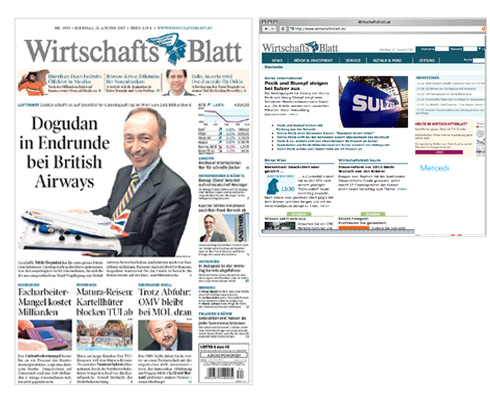Vienna is a city where traditions—-think Johann Strauss, king of the waltz and, of course, the legendary Sache torte—-mix with a city bustling with modern glass buildings and chic restaurants on the side of the Danube.
For Mario Garcia Sr. the mix of the new and the old, has served as the foundation for a series of workshops with the news folks at one of Austria’s leading financial dailies, Wirtschafts Blatt, an example of a newspaper that is trying to leave the “paper” label behind, to fuse with its online operation and become a 24/7 news dispensing publishing house.
When Dr. Hans Gasser, publisher and general manager, asked Garcia to work with his team, he set the stage for fast and innovative ideas that would create a news center inside the newsroom and one in which the lines between ONLINE and PRINT would eventually be totally erased. Alexis Johann, the young online editor, has led the workshops internally as we take up the subject of what Garcia refers to as “the path of the story”.

The path of the story
Here we deal with the evolution of a news item from report (usually first reported in five lines on the mobile telephone), to the online lead (first that this appears on the their website), to the printed version that appears usually 16 hours later or more, and then the final stop, which will take place online.
In order to achieve this, we must have the NEWS folks sitting together and, preferably, NOT tied to titles such as news editor for online, or news editor for rent. That is first NECESSARY step.
The next important step is what Garcia calls the “passing of the torch”, a reference that I get from seeing Olympic tradition of the torch passed from one host city to the next.
The passing of the torch in a modern newsroom is that moment when the editors who have controlled a specific story (or stories) for a portion of the day UPDATE their colleagues picking up the task. AT the WB, this takes place twice a day at least, at 10 am, and at 4 pm.
Rather than come to the 10 am meeting, in the traditional manner, to discuss what will be in tomorrow’s newspaper, there is no reference to today or tomorrow, MORE like this hour and the next.
Most importantly, and one major goal of the workshop with the WB editors is the entire operation is changing from being a traditional newspaper to becoming a 24/7 financial news provider.
Alexis Johann describes the success of the workshops to fuse online
and print at the WB:
·” The general attitude towards “integration” and the genera mood switched completely. Remember, when we asked for the degree of integration? We were at somewhere 20 to 30 Percent from 100? I dare say, that we reach 60 percent by now.
“Morning meetings of editors now take 50 minutes – compared to 20 minutes before fusion m. There is more discussion on story-telling.
“Nearly 90 percent of editors think print and online now in their daily workflow. and 80 percent know how to – and actually do use – the online-publishing system by now. There is more than a handful of editors, who told me his satisfaction with the change one or the other day. One citation out of that: “I cannot name the reason, but I feel, that there is something going on here. Something good, something I like, something that makes me feel good with my job, far more than I had this feeling before.”
The fear, that “Online First” is killing a story, disappeared for most of the editors.
Tip for those considering total fusion: Go in knowing that this is not an overnight process, that it takes tremendous time, effort and work to convince traditional print editors. Management plays a key role. Remind editors that they trained to be storytellers and now they have a better way to tell their stories. Go slowly. Bring down the physical barriers in the newsroom, and abandon